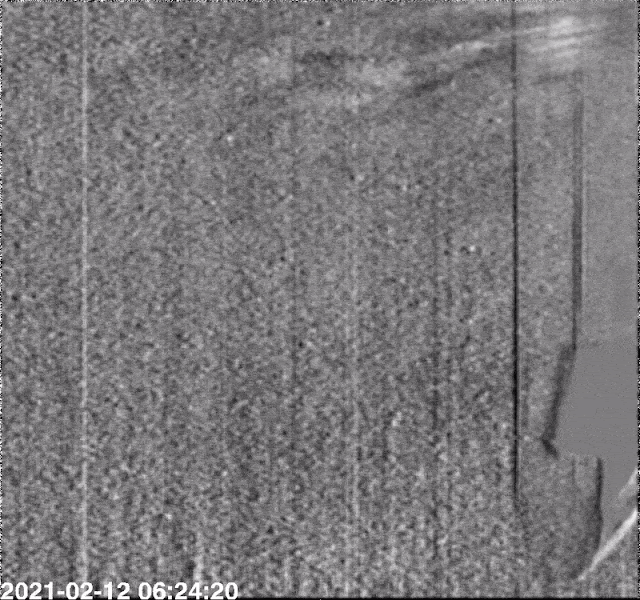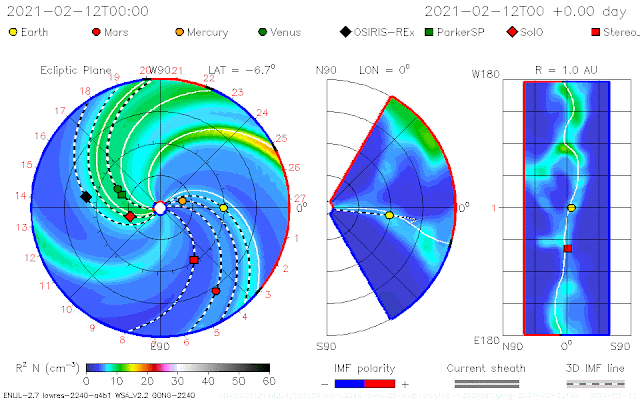ESA & NASA - Solar Orbiter Mission patch.
May 17, 2021
- First Solar Orbiter movies showing coronal mass ejections (CMEs)
- A pair of CMEs were detected by multiple instruments during February’s close flyby of the Sun
- CMEs are eruptions of particles from the solar atmosphere that blast out into the Solar System and have the potential to trigger space weather at Earth
- Solar Orbiter will begin its main science mission in November this year
- Solar Orbiter is a space mission of international collaboration between ESA and NASA
Cruise phase checkouts
Solar Orbiter launched on 10 February 2020 and is currently in cruise phase ahead of the main science mission, which begins November this year. While the four in situ instruments have been on for much of the time since launch, collecting science data on the space environment in the vicinity of the spacecraft, the operation of the six remote sensing instruments during cruise phase is focused primarily on instrument calibration, and they are only active during dedicated checkout windows and specific campaigns.
Multipoint view of a coronal mass ejection
A close perihelion pass of the Sun on 10 February 2021, which took the spacecraft within half the distance between Earth and the Sun, was one such opportunity for the teams to carry out dedicated observations, checking instrument settings and so on, in order to best prepare for the upcoming science phase. In full science mode, the remote sensing and in situ instruments will routinely make joint observations together.
Animation above: The first coronal mass ejection, or CME, observed by the Solar Orbiter Heliospheric Imager (SoloHI) appears as a sudden gust of white (the dense front from the CME) that expands into the solar wind. This video uses difference images, created by subtracting the pixels of the previous image from the current image to highlight changes. The missing spot in the image on the far right is an overexposed area where light from the spacecraft solar array is reflected into SoloHI’s view. The little black and white boxes that blip into view are telemetry blocks – an artifact from compressing the image and sending it back down to Earth. Animation Credits: ESA & NASA/Solar Orbiter/SoloHI team/NRL.
At the same time as the close solar pass, the spacecraft was ‘behind’ the Sun as viewed from Earth, resulting in very low data transfer rates. The data from the close flyby have therefore taken a long time to be completely downloaded and are still being analysed.
Chance observations
By happy coincidence, three of Solar Orbiter’s remote sensing instruments captured a pair of coronal mass ejections in the days after closest approach. The Extreme Ultraviolet Imager (EUI), the Heliospheric Imager (SoloHI) and the Metis coronagraph captured different aspects of two CMEs that erupted over the course of the day.
Animation above: The modeled path of the CME observed by SoloHI on February 12, 2021. The plot on the far left shows the Sun as a white circle in the center, and the inner planets and some spacecraft appear in their positions in orbit. The center and right panels show different angles of the same model, focusing on Earth. Animation Credits: NASA’s Goddard Space Flight Center/M2M/CCMC.
The CMEs were also seen by ESA’s Proba-2 and the ESA/NASA Solar and Heliospheric Observatory (SOHO) from the ‘front’ side of the Sun, while NASA’s STEREO-A, located away from the Sun-Earth line, also caught a glimpse, together providing a global view of the events.
Solar Orbiter’s multi-instrument view of a coronal mass ejection
EUI’s view of February 2021 CME
Metis views of February 2021 CME
Metis running difference views of February 2021 CME
Solar eruption glimpsed by SoloHI
12 February 2021 CMEs seen by Proba-2 and SOHO
For Solar Orbiter’s SoloHI, this was the first coronal mass ejection seen by the instrument; Metis previously detected one on 17 January, and EUI detected one in November last year, while the spacecraft’s in situ detectors bagged their first CME soon after launch in April 2020. Many of the in situ instruments also detected particle activity around the February 2021 CMEs; the data are being analysed and will be presented at a later date.
Solar Orbiter instruments. Animation Credits: NASA/ESA
For SoloHI the CME sighting was particularly serendipitous, captured during ‘bonus’ telemetry time. Upgrades in Earth-based antennas made since after the mission was planned allowed the team to downlink data at times they previously didn’t expect to be able to, albeit at lower telemetry rates. They therefore decided to collect just one tile’s worth of data (the instrument has four detector tiles) at a two-hour rate, and happened to capture a CME during that time.
EUI’s first coronal mass ejection
Space weather
CMEs are an important part of ‘space weather’. The particles spark aurorae on planets with atmospheres, but can cause malfunctions in some technology and can also be harmful to unprotected astronauts. It is therefore important to understand CMEs, and be able to track their progress as they propagate through the Solar System.
Studying CMEs is just one aspect of Solar Orbiter’s mission. The spacecraft will also return unprecedented close-up observations of the Sun and from high solar latitudes, providing the first images of the uncharted polar regions of the Sun. Together with solar wind and magnetic field measurements in the vicinity of the spacecraft, the mission will provide new insight into how our parent star works in terms of the 11-year solar cycle, and how we can better predict periods of stormy space weather.
Solar Orbiter: https://www.esa.int/Science_Exploration/Space_Science/Solar_Orbiter
Images, Animation (mentioned), Videos, Text, Credits: ESA/Solar Orbiter/EUI Team/Metis Team/SoloHI team/ESA & NASA/Royal Observatory of Belgium; SOHO: SOHO (ESA & NASA).
Greetings, Orbiter.ch





